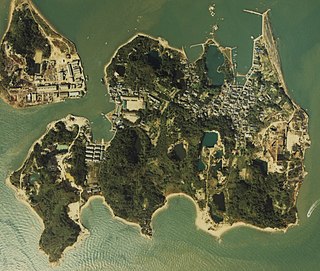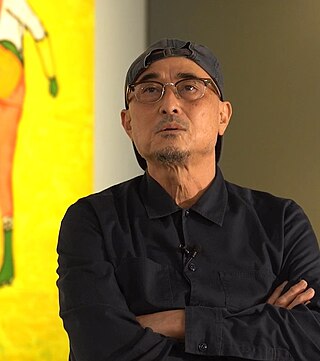
Naoshima is an island in Japan's Seto Inland Sea, part of Kagawa Prefecture. The island is best known for its many contemporary art installations and museums. The Town of Naoshima administers Naoshima and 26 smaller islands nearby. As of 2020, the town has an estimated population of 3,026 and a density of 210 persons per km2. The total area is 14.22 km2.

Benesse Corporation is a Japanese company which focuses on correspondence education and publishing. Based in Okayama-City, it is the parent company of Berlitz Language Schools, which in turn is the parent company of ELS Language Centers. Benesse is listed on the Tokyo Stock Exchange.

The Singapore Biennale is a large-scale biennial contemporary art exhibition in Singapore, serving as the country’s major platform for international dialogue in contemporary art. It seeks to present and reflect the vigour of artistic practices in Singapore and Southeast Asia within a global context, fostering collaboration and engagement between artists, arts organisations, and the international arts community.
Soichiro Fukutake is a Japanese billionaire, and the former chairman of the Benesse Corporation, a publishing firm and juku company known for its patronage of the arts.

Teresita Fernández is a New York-based visual artist best known for her public sculptures and unconventional use of materials. Her work is characterized by a profound reconsideration of landscape and issues of visibility. Fernández’s practice generates psychological topographies that prompt the subjective reshaping of spatial and historical awareness. Her experiential, large-scale works are often inspired by natural landscapes, investigating the historical, geological, and anthropological realms in flux. Her sculptures present spectacular optical illusions and evoke natural phenomena, land formations, and water in its infinite forms.

The Chichu Art Museum is a museum built directly into a southern portion of the island of Naoshima in Kagawa Prefecture, Japan. It was designed by architect Tadao Ando and opened to the public on July 18, 2004.

Fumio Nanjo is a curator and art historian. Between 2006 and 2019 he was the director of the Mori Art Museum in Tokyo. A graduate of Keio University, Nanjo was previously Director of the Institute of Contemporary Arts in Nagoya (1986–1990) and served as commissioner of the Japan Pavilion at the Venice Biennale (1997).
Miwa Yanagi is a Japanese photographic artist who examines self-image and stereotypes of women in contemporary Japanese society. Yanagi was discovered by conceptual photographer Yasumasa Morimura, who noticed some of her work while borrowing her house as a set for a separate project.

When Loud Weather Buffeted Naoshima is a limited edition CD by English musician David Sylvian that was commissioned as an installation piece by the Naoshima Fukutake Art Museum Foundation on the island of Naoshima, Japan, as part of the "NAOSHIMA STANDARD 2" exhibition which ran from October 2006 to April 2007. The album consists of one long ambient instrumental track. Writing in The Guardian, John L. Walters described it as "possibly the most avant-garde product made by a pop musician since Metal Machine Music".

Inujima is a Japanese island in the Seto Inland Sea, located near the coast of Okayama Prefecture. It is part of Higashi-ku, Okayama.

Shinro Ohtake is a Japanese artist who was born in Tokyo and lives in Uwajima, Japan. He paints, creates installations and designs record covers and book covers. He has published dozens of books, such as a dream diary, a picture book, essays and art books.

Rei Naito is a Japanese artist. Naito's work intersects with minimalism, conceptual art, and environmental art, exploring the ways in which human existence is shaped, felt, and made evident amidst its natural surroundings. Using organic and found materials and creating immersive environments that interact with sound, light, and atmosphere, Naito's practice takes a strong interest in the intimate, ambient, and often transient encounters that arise between individuals and artworks.
Tatsuo Miyajima is a Japanese sculptor and installation artist who lives in Moriya, in Ibaraki prefecture, Japan. His work frequently employs digital LED counters and is primarily concerned with the function and significance of time and space, especially within the context of Buddhist thought.
Makoto Azuma is a Japanese flower artist, botanical sculptor, and co-founder of JARDINS des FLEURS.

The Setouchi International Art Triennale is a contemporary art festival held every three years on several islands in the Seto Inland Sea of Japan and the coastal cities of Takamatsu and Tamano. The festival was inaugurated in 2010 with the aim of revitalizing the Seto Inland Sea area, which has suffered from depopulation in recent years, as well as long-standing environmental degradation from illegal industrial waste-dumping practices conducting during the 1970s following rapid industrialization in the area.
Adrián Villar Rojas is an Argentinian sculptor known for his elaborate fantastical works which explore notions of the Anthropocene and the end of the world. In his dream like installations he uses aspects of drawing, sculpture, video and music to create immersive situations in which the spectator is confronted with ideas and images of their imminent extinction.
Kyun-Chome (キュンチョメ) is a Japanese artist unit based in Tokyo, made up of Nabuchi and Honma Eri. They emerged as an art unit after the 2011 Great East Japan Earthquake, and rose to prominence after winning the 17th Taro Okamoto Art Award in 2014.
Bontarō Dokuyama is a Japanese contemporary artist from Fukushima who employs a wide range of methodologies and approaches in his body of work, including political activism, interviews, installation, and video.
Hikaru Fujii is a contemporary Japanese artist who explores the relationship between art, history, and social activism. Primarily working in documentary film and multi-channel video installation, Fujii employs archival research, fieldwork, interviews, and workshops to create artworks to examine the relationships between historical narrative and education, structural violence, crisis, race, and power. Of particular interest for him are the role and responsibility of museums and institutions as sites that preserve and perpetuate specific historical narratives. After the 2011 Great East Japan Earthquake and nuclear disaster, Fujii has actively documented the disaster and raised awareness around the world about the situation in Japan.
Hideaki Fukutake is a Japanese New Zealand businessman and arts patron based in New Zealand since 2009. He is CEO of New Zealand company STILL that is focused on New Zealand-based opportunities to enhance art, culture and community through business, social enterprise and projects. He is a Director of Benesse Holdings in Japan and Chairman of the Fukutake Foundation which operates Benesse Art Site Naoshima and is an important contributor to the world-renowned Setouchi Triennale.











